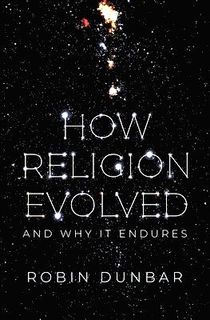Man – a religious being
Review of Robin Dunbar, How Religion Evolved: And Why It Endures.

In 2022 the well-known evolutionary psychologist Robin Dunbar published How Religion Evolved, And Why It Endures as part of the project "Religion and the Social Brain", funded by the Templeton Religion Trust.
It is a likeable book with a positive attitude towards religion and spirituality. The author is well versed in Christianity, has a good knowledge of both the Bible and the church history, and has understanding and empathy in terms of spiritual forms of expression. He believes that because cognitive science research on religion primarily focuses on religious beliefs, it misses many important elements of the human religious experience. There is a mysticism with strong emotional overtones that underlies all forms of religious behavior, however sophisticated the religion in question may be. This component is the driving force of religion.
He identifies the main function of religion as the cohesion of a group. Then there are secondary benefits in place that arise religion. Once a religion has evolved, it offers direct health benefits and an improved understanding of the world. Being actively religious, opposed to just showing up to services once in a while, seems to make people feel like part of a larger group of people who are likely to lend their support when needed. Then they feel happier and satisfied with life in general.
The author
has become known for the concept »Dunbar´s number».
He has found a correlation between the brain size of primates and the
average social group size. A normal person can maintain stable contact
in a group with about 150 people where you know everyone. This would then
be the ideal size for a Christian congregation.
Congregations, churches and religions are human organizations made up
of individuals who, when left to fend for themselves, naturally develop
their own beliefs, but eventually drift apart culturally and intellectually.
If a group consists of less than 150 people, those kinds of differences
can be resolved by talking to each other in person and agreeing on compromises.
But if the group becomes significantly larger, these mechanisms no longer
work. It is then difficult to maintain the personal relationship, and
the group tends to split.
Dunbar, who has his background in the Anglo-Saxon world, presupposes organized and nuanced religions, not private religiosity. The question is to what extent his reasoning can be applied in the Swedish folk church situation where so many are privately religious. What happens when the remains of the Swedish state church are converted into a therapeutic hobby?
Animism is the oldest form of religion. During the last 70,000 years, different people groups have migrated across the continents. Increasingly, conflicts have arisen between different tribes, something that Dunbar shows with a large number of examples.
Belief in great gods did not exist among hunters and gatherers, but first arose in agricultural societies. Ritual sites, symbolic representations, priestly castes, moral norms are absent in hunter-gatherer societies, but when we enter urban environments where one has to deal with contradictions, it becomes different.
About 2000 years before Christ there were what he calls doctrinal religions and priestly castes. Storage of food shows that there was a surplus, suggesting that religious specialists appear when a society is sufficiently affluent to spare food for a few individuals who can devote their time to being religious specialists. This suggests that a priestly caste – unlike the individual shamans of hunter-gatherer societies – appears only when agricultural production is large enough.
Unlike biological evolution, which lacks direction, religious evolution has gone through the natural sequence through which all societies evolve as circumstances demand. This is because they are community-level solutions that arise when the problem of social community increases as societies grow larger over the course of history. They represent the amazing adaptability of the human species.
The ability to interact with a transcendent world seems to be important for two reasons. First, our neurobiological basis for social community is activated, thereby creating a sense of commitment and loyalty in a way that no abstract ideological belief could. Second, the religious dimension seems able to expand in a way that few of our other social behaviours seem to do. Religion therefore contributes effectively to creating cohesion in a group in what is likened to a one-dimensional club.
Is a secular religion possible, which has the same edifying function but still does not require belief in a transcendent world? The attempts to create humanistic religions in the 19th and 20th centuries are not promising. When various communist regimes in the 20th century tried to eradicate religion and replace it with some kind of secular philosophy, it ended in disaster, as we know, something that speaks against that possibility. The environmental movement and its latest manifestation in Extinction Rebellion show many similarities in terms of the visionary purpose, the charismatic people and the sense of acting together. But its secular focus makes it difficult to gather support from the general public.
In short, it is difficult to see a convincing support for something that could replace religion in our story of man. Having a religion is a deeply human trait. Its content will certainly change in the longer term, but for better or worse it will probably remain a part of our existence.
Anders Brogren
Dean h.c., Falkenberg, Sweden
Sankt
Lars Kyrkogata 4
S-311
31 Falkenberg
SWEDEN
Mail
to
anders [ at ] brogren.nu